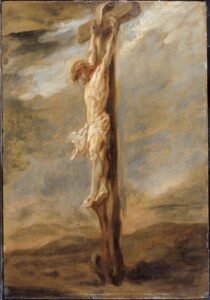
“Tetelestai”
After this, Jesus, knowing that all was now finished, said (to fulfill the Scripture), “I thirst.” A jar full of sour wine stood there, so they put a sponge full of the sour wine on a hyssop branch and held it to his mouth. When Jesus had received the sour wine, he said, “It is finished,” and he bowed his head and gave up his spirit. ~ John 19:28-30, ESV
We were talking about tattoos. I had just made an online appointment at Razzouk Tattoo in Jerusalem’s Old City ahead of my 2019 trip to the Holy Land. I was explaining to my friend how, in the manner of thousands of pilgrims to the Holy Land over the centuries, I planned to have a small Jerusalem cross tattooed inside my left wrist. “Well, I don’t know if I’ll ever get a tattoo,” she mused, “but if I do, I know exactly what it will be. One word, in Greek letters, near my hand where I will constantly see it: ‘τετέλεσται (tetelestai).’”

We paused as the weighty meaning of the word sank in. “It is finished,” I spoke, feeling the ponderous substance of it in my body, seeing the word hanging there in the air as Jesus hung on the cross. What does this word, this phrase, mean to you? What about it would inspire a tattoo-averse person to consider having it needled into her body?
There could be at least three interpretations of Jesus’ cry from the cross; “It is finished:”
1. “My suffering is finally finished!”
2. “I have done it—satisfied the Father’s wrath: the penalty for all sin has been paid in full!”
3. “I have accomplished everything I came here to do!”
I’m just going to dismiss that first option because it denies that Jesus clearly knew well what he was to endure and spoke about it to his disciples (see John 12-19, as just one example). The second meaning, “Paid in full,” is true enough, and worth celebrating, but is a simplified statement of all Jesus accomplished on the cross.[1] That leaves the third option: “I have finished/completed/accomplished everything I came here to do!”
Which raises the question: What did Jesus come here to do? (How would you answer?) Wrapped up in that question are multiple others: What is the Gospel? Why did Jesus have to die? What did Jesus accomplish in his relatively short time walking this earth? And to what does the phrase in our weekly eucharistic liturgy, “forgiveness of our sins, and all other benefits of his passion” refer? What “benefits?”
 Stated in its simplest form an answer might be, “Jesus was sent into the world in order that people might have life in relationship with God. The goal of his being sent…is that people might ‘come’ to the Father, which… means that they might know and believe in God.”[2] Life in relationship with God, as God intended from the very beginning, is as it appears in the Garden, where God dwelt with humans until sin destroyed that relationship. Jesus dwelt with us in his days on earth (John 1), and through his ultimate victory over death through resurrection he made a way for God to once again dwell with us forever through the gift of Holy Spirit! The entire arc of Scripture from Genesis through the Psalms and the Prophets; from the first Creation to the New Creation; from the Adamic Covenant through the covenants with Noah, Abraham, Moses, and David; from the tabernacle of the Ark to the tabernacle in the wilderness to the first and second temples; all Scripture points to the New Creation, the New Covenant, the New Temple, a new way to be human!
Stated in its simplest form an answer might be, “Jesus was sent into the world in order that people might have life in relationship with God. The goal of his being sent…is that people might ‘come’ to the Father, which… means that they might know and believe in God.”[2] Life in relationship with God, as God intended from the very beginning, is as it appears in the Garden, where God dwelt with humans until sin destroyed that relationship. Jesus dwelt with us in his days on earth (John 1), and through his ultimate victory over death through resurrection he made a way for God to once again dwell with us forever through the gift of Holy Spirit! The entire arc of Scripture from Genesis through the Psalms and the Prophets; from the first Creation to the New Creation; from the Adamic Covenant through the covenants with Noah, Abraham, Moses, and David; from the tabernacle of the Ark to the tabernacle in the wilderness to the first and second temples; all Scripture points to the New Creation, the New Covenant, the New Temple, a new way to be human!
All of this is what Jesus accomplished in his life, death, and resurrection.
“The tabernacle and Solomon’s temple were always designed as small working models of the intended new creation,” writes N.T. Wright.[3] “Now, …the disciples are to be the living and active temple in which the Spirit dwells—the new reality corresponding to the promise of Ezekiel 43 [where the glory of the LORD fills the temple]—with the living water flowing from this temple, as from the garden of Eden, to refresh and irrigate the whole world.”
By “It is finished,” Jesus was declaring that Scripture was fulfilled. Look carefully at the wording in John 19:28-30:
“Jesus, knowing that all things were completed [tetelestai],
that the Scripture might be fulfilled [teleiōthē, a word play on tetelestai],
said, ‘I am thirsty’… then when he had taken the sour wine, he said,
‘It is finished [tetelestai].’”[4]
This final cup of Passover wine, the fourth cup, completed Jesus’ work: now he could surrender his life and spirit to the Father.
Importantly, tetelestai is in the perfect tense in Greek. That is significant because the perfect tense speaks of an action that has been completed in the past with results continuing into the present. It’s different from the past tense which looks back to an event and says, “This happened.” The perfect tense adds the idea that “This happened and it is still in effect today.” When Jesus cried out “It is finished,” he meant “It was finished in the past, it is still finished in the present, and it will remain finished in the future.”[5] While the world may see Jesus’s death as an ending, we who are called by his name understand that Jesus created a new beginning.
This, all this, is what my friend wants to keep ever in view, whether she has it tattooed or not: because I have believed that Jesus is the Son of God, there is nothing more I can or must do to earn my salvation, to earn God’s love, and to have a direct relationship with God the Father. Jesus has done it all for me and for the whole world, past, present, and future. τετέλεσται: A single word that reminds us how our own story ends. We WIN. It is finished! God has done it! With Jesus we can utter his cry of victory:
Tetelestai!
Karalee Romaneski
Junior Warden
[1] Though tetelestai commonly is interpreted as such, “paid in full” refers to another derivative of the Greek root tetel, which, based on much scholarly study, has been found to refer only to taxes that have been paid. No one would suggest that Jesus was crying out, “Taxes are paid!” in his final moments on the cross.
[2] Craig R. Koester, “Jesus as the Way and the Mission of the Church According to the Gospel of John.” https://www.vanderbilt.edu/AnS/religious_studies/SNTS2002/Koester.htm – :~:text=Jesus was sent into the,know and believe in God.
[3] N. T. Wright, “Understanding the Divine: Insights from John’s Gospel.” https://www.ntwrightonline.org/portfolio-items/johns-gospel-free-ebook/, 2017.
[4] Gary Manning, Jr., “’Paid in Full’? The Meaning of τετέλεσται (Tetelestai) in Jesus’ Final Words.” (April 20, 2022) https://www.biola.edu/blogs/good-book-blog/2022/paid-in-full-the-meaning-of-tetelestai-in-jesus-final-words
[5] Dr. Ray Pritchard, “The Meaning of Tetelestai – ‘It is Finished.’” (January 17, 2022) https://www.christianity.com/jesus/death-and-resurrection/last-words/what-was-finished.html

